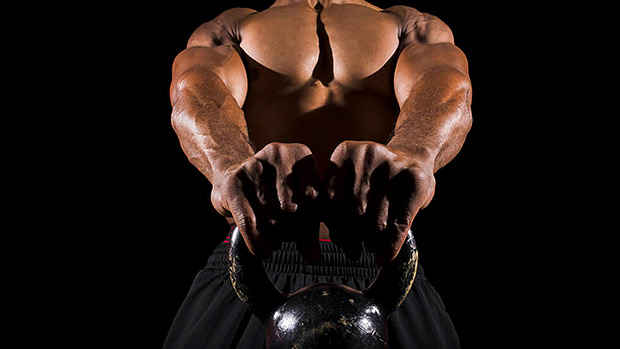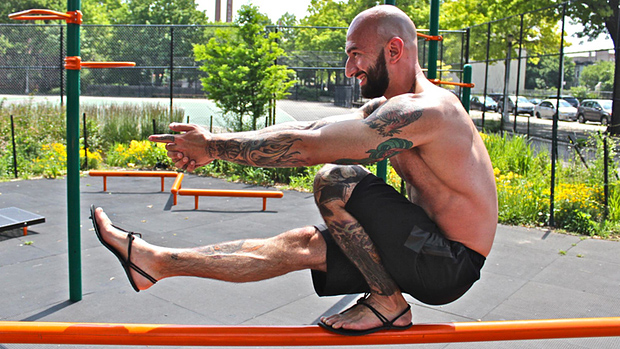Note: The program below is a byproduct of a strength-endurance protocol for athletes that I worked on with strength coach Pavel Tsatsouline. Trainees who used the program routinely complained about their clothing no longer fitting properly: their shoulders got bigger and their waist sizes got smaller.
Myofibrillar hypertrophy is the growth of muscle contractile parts, specifically actin and myosin. They equate to strength, speed, and a "functional" type of muscle growth. It's the muscle of a lean African leopard and it's what you see in elite sprinters, boxers, and gymnasts.
It stands in stark contrast to sarcoplasmic hypertrophy, which is the increase of plasma, organelles, and non-contractile proteins with no increase in strength. You can think of water-injected chicken breast at the supermarket as an example of sarcoplasmic hypertrophy.
In contrast to most bodybuilding programs, the one presented below details a 6-week protocol that concentrates on lean, striated myofibrilliar hypertrophy while burning fat and building the type of endurance needed to carry 160-pound kegs up multiple sets of stairs (as Dr. Fred Hatfield described it).
Here's a quick overview, then we'll break down the training and dig into the science behind it.
This program consists primarily of heavy kettlebell swings and double kettlebell presses. Do this 3 days per week:
A1. Kettlebell Swings
Complete 25 heavy kettlebell swings (40-48kg for strong gentlemen; 20-24kg for strong ladies).
These swings should be as powerful as possible. If you lose form or more than 10% of your power, you've chosen the wrong weight. You need to fight to the end without looking like you're fighting to the end. Once completed, briefly catch your breath (for two minutes) and do the next series of exercises.
A2. Double Kettlebell (or Dumbbell) Presses
Do 3 sets over a 10-minute period. You want your presses to be crisp and powerful. Don't grind out reps. Instead, go grab a lighter weight or take more rest.
- 2 minutes after doing kettlebell swings: 7-8 reps of presses at 65% of 1RM
- 4 minutes after doing kettlebell swings: 2-3 reps of presses at 85% of 1RM
- 7 minutes after doing kettlebell swings: 5-6 reps of presses at 75% of 1RM
- Rest for two minutes and repeat this series (A1 and A2) two to four more times, depending on the day of the week.
- Monday: Go through the series 3 times (75 total swings and about 45 presses).
- Wednesday: Go through the series 5 times.
- Friday: Go through the series 4 times.

- On other weight training days, work abs, squats, and upper-body pulls. There's no need to train lower body pulls or upper-body presses as you're already getting plenty of volume on those movements. If you're an endurance athlete, you can also train long, slow distances, but in general, avoid other glycolytic, burn-types of exercises while on this program.
- Maintain this program for 6 weeks. It should be cycled every 3 months at most.
Build Endurance
The general goal is to drain the ATP stores from our system as quickly as possible. That's why we need maximum effort on every set. When we use up our ATP, our body initiates a complex mechanism that starts building new mitochondria, which builds more endurance.
To be more specific, by using our ATP, we trigger AMPK, which signals the need for more mitochondria and better endurance. (While research on long, slow, endurance training has shown AMPK to inhibit mTOR, which regulates, among other things, cellular growth, it's not the case with this style of training.)

Grow the Muscles
Pushing sets over 15 seconds leads to a big increase in the acidic environment as the glycolytic system kicks in to create more ATP. We can use this acidic rest period to trigger hypertrophy because it allows us to maximally utilize the hormone system to create body composition changes.
Train Like Sprinters
This protocol uses high-intensity repeat training (HIRT). The key difference between HIRT and HIIT is that we repeat each high-level performance, whereas interval training builds up fatigue and leads to declining performance over the intervals. In our protocols, we want 90% power across the complete set with no decline over time.
In HIIT training, the rest interval is short and the build-up of acid reduces performance over each accumulating set. In our repeat training protocol, we wait ten minutes between doing our sets of kettlebell swings, which take about 20 seconds.
This type of training is similar to what sprinting coach Charlie Francis did. He wanted every sprint to be perfect, so he needed the ATP system to be fully replenished before the next set. His training started with 10 minutes of rest between the first set and the second, but the rest increased over the course of the training session.
By providing enough rest between sets, we optimize power for every rep. When we're powerful on each rep, we optimize our genetic ability to convert type IIX fibers (fast-twitch glycolytic). We might not all be built to be lean, athletic sprinters, but we can get as close to our genetic limits as possible.
We also reap the benefit of an acidic environment by doing power sets that last over 20 seconds, which, when followed by the double kettlebell presses, leads to muscular growth. (Our first few studies on this type of protocol were quite successful to that end, but we're undertaking a more formal research protocol with more control.)

I don't care if you become bored with this protocol. Your boredom isn't related to the results. However, if you're unable to do powerful swings or lack suitable shoulder mobility for presses, I can offer a few variations.
For the endurance portion, we need an exercise that taps into maximum power. I recommend sled pushes or uphill sprints instead of sprints. These will help you find your power sweet spot. However, you don't want to push the sled as fast as you can, nor do you want to push it slowly.
Power will optimize both speed and strength. Finding your maximum power will provide the training stimulus needed to maintain maximum effort for 20 seconds.
For the upper body, double kettlebell presses are a great overall movement, but you can do landmine presses if you don't have the proper shoulder mobility. Pull-ups are also an option. Power is also important here, so you don't want to grind out reps.
- Burgomaster KA et al. Effect of short-term sprint interval training on human skeletal muscle carbohydrate metabolism during exercise and time-trial performance. J Appl Physiol (1985). 2006 Jun;100(6):2041-7. PubMed.
- Burgomaster KA et al. Similar metabolic adaptations during exercise after low volume sprint interval and traditional endurance training in humans. J Physiol. 2008 Jan 1;586(1):151-60. PubMed.
- Gibala MJ et al. Short-term sprint interval versus traditional endurance training: similar initial adaptations in human skeletal muscle and exercise performance. J Physiol. 2006 Sep 15;575(Pt 3):901-11. PubMed.
- Lo MC et al. Glycoxidative stress-induced mitophagy modulates mitochondrial fates. Ann N Y Acad Sci. 2010 Jul;1201:1-7. PubMed.
- López-Lluch G et al. Mitochondrial biogenesis and healthy aging. Exp Gerontol. 2008 Sep;43(9):813-9. PubMed.
- Fiorenza M et al. Metabolic stress-dependent regulation of the mitochondrial biogenic molecular response to high-intensity exercise in human skeletal muscle. J Physiol. 2018 Jul;596(14):2823-2840. PubMed.





